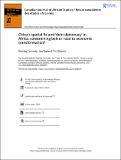Files in this item
China’s spatial fix and ‘debt diplomacy’ in Africa : constraining belt or road to economic transformation?
Item metadata
| dc.contributor.author | Carmody, Pádraig | |
| dc.contributor.author | Taylor, Ian | |
| dc.contributor.author | Zajontz, Tim | |
| dc.date.accessioned | 2021-03-12T16:30:02Z | |
| dc.date.available | 2021-03-12T16:30:02Z | |
| dc.date.issued | 2021-02-08 | |
| dc.identifier | 273278556 | |
| dc.identifier | 24194202-e78a-4811-870c-465fb7eae407 | |
| dc.identifier | 85100710071 | |
| dc.identifier | 000616185600001 | |
| dc.identifier.citation | Carmody , P , Taylor , I & Zajontz , T 2021 , ' China’s spatial fix and ‘debt diplomacy’ in Africa : constraining belt or road to economic transformation? ' , Canadian Journal of African Studies , vol. Latest Articles , pp. 1-21 . https://doi.org/10.1080/00083968.2020.1868014 | en |
| dc.identifier.issn | 0008-3968 | |
| dc.identifier.other | Jisc: efd82dde988e4a3b968aa798939d262b | |
| dc.identifier.uri | https://hdl.handle.net/10023/21625 | |
| dc.description | Tim Zajontz’s research for this article was conducted under a European Research Council (ERC) Advanced Grant for the project African Governance and Space: Transport Corridors, Border Towns and Port Cities in Transition (AFRIGOS) [ADG-2014-67085 | en |
| dc.description.abstract | Mounting overaccumulation of capital and material has compelled the Chinese government to seek solutions overseas. The Belt and Road Initiative (BRI), with its transregional infrastructure projects connecting Eurasia and Africa, is the hallmark venture in this effort. Chinese road, railway, port and energy projects, implemented under the BRI banner, have become widespread in Africa. This article traces drivers of the BRI in the post-reform evolution of the Chinese economy and conceptualises the BRI as a multi-vector “spatial fix” aimed at addressing chronic overaccumulation. Focusing on Kenya, Djibouti and Ethiopia, the paper documents how loan financing related to BRI projects reveals contradictions that arise from China’s spatial fix in Africa. Concerns about a looming debt crisis on the continent and the questionable economic sustainability of some BRI projects have become more pressing amidst the COVID-19-induced economic contraction. Hopes for Africa’s economic transformation based on increasing connectivity under the BRI are unlikely to materialise. | |
| dc.format.extent | 21 | |
| dc.format.extent | 895661 | |
| dc.language.iso | eng | |
| dc.relation.ispartof | Canadian Journal of African Studies | en |
| dc.subject | Development | en |
| dc.subject | Cultural studies | en |
| dc.subject | Sociology and political science | en |
| dc.subject | History | en |
| dc.subject | Demography | en |
| dc.subject | Anthropology | en |
| dc.subject | DT Africa | en |
| dc.subject | HB Economic Theory | en |
| dc.subject | JZ International relations | en |
| dc.subject | T-NDAS | en |
| dc.subject | SDG 10 - Reduced Inequalities | en |
| dc.subject.lcc | DT | en |
| dc.subject.lcc | HB | en |
| dc.subject.lcc | JZ | en |
| dc.title | China’s spatial fix and ‘debt diplomacy’ in Africa : constraining belt or road to economic transformation? | en |
| dc.type | Journal article | en |
| dc.contributor.institution | University of St Andrews. School of International Relations | en |
| dc.identifier.doi | https://doi.org/10.1080/00083968.2020.1868014 | |
| dc.description.status | Peer reviewed | en |
This item appears in the following Collection(s)
Items in the St Andrews Research Repository are protected by copyright, with all rights reserved, unless otherwise indicated.

